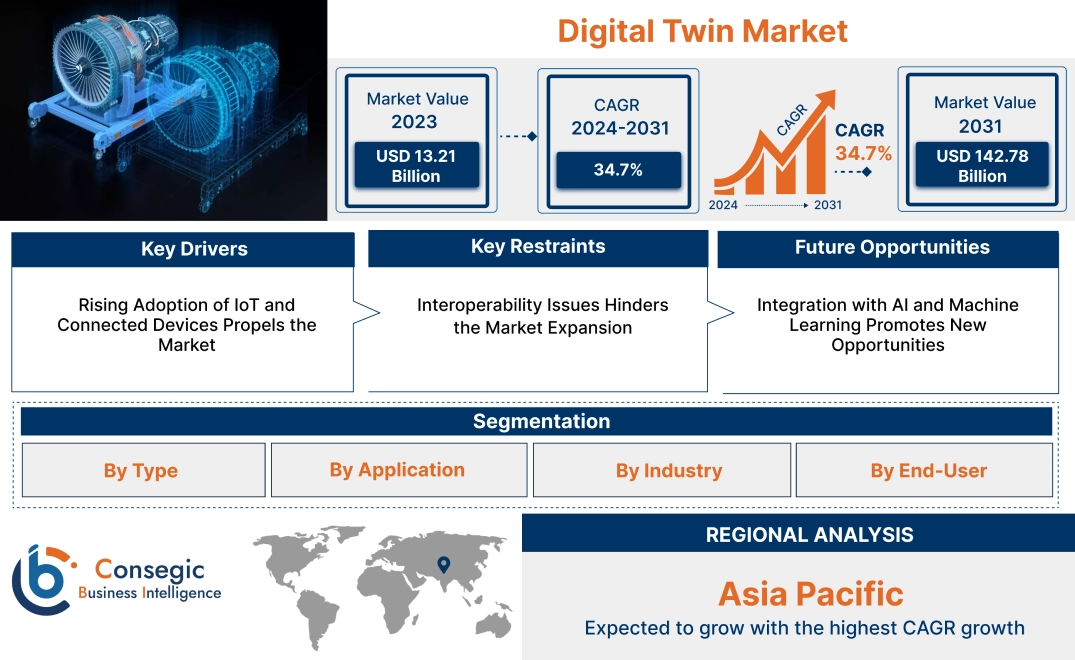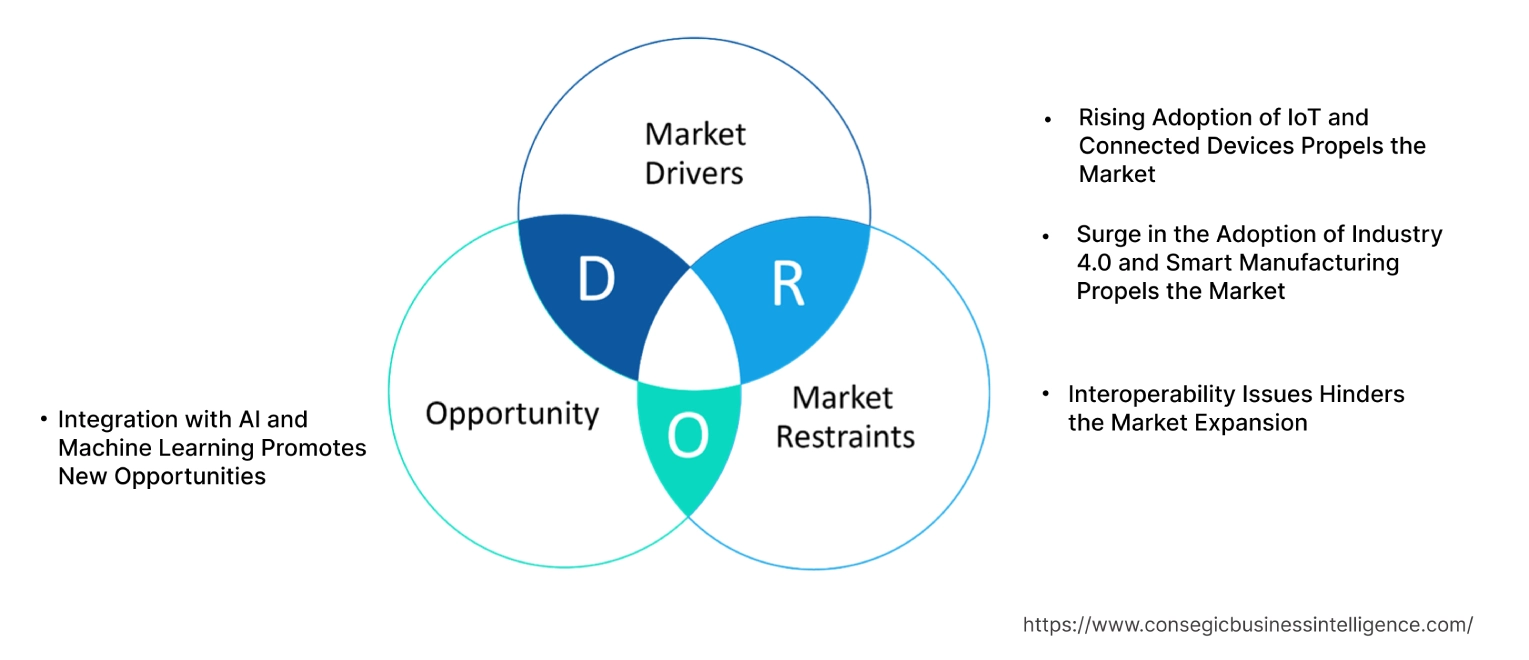- Summary
- Table Of Content
- Methodology
Digital Twin Market Size:
Digital Twin Market size is estimated to reach over USD 142.78 Billion by 2031 from a value of USD 13.21 Billion in 2023 and is projected to grow by USD 17.55 Billion in 2024, growing at a CAGR of 34.7% from 2024 to 2031.
Digital Twin Market Scope & Overview:
A digital twin is the virtual replica of physical objects or systems, represented accurately. It uses real-time data to update the object throughout its life cycle. Its advantages range from optimization and rapid iterations of the product design, troubleshooting, and identifying threats to constant monitoring of real-time data and improving collaboration. They are used in product design and prototyping, design visualization, 3D car design and product development, virtual safety training, and many more applications. The primary end industries include construction, manufacturing, energy, automotive, and healthcare.
Digital Twin Market Insights:
Key Drivers:
Rising Adoption of IoT and Connected Devices Propels the Market
IoT and connected devices pave the way for the virtual replicas to interact with the physical devices. The data collected through IoT sensors perform the groundwork for different types of digital twins.
Additionally, the continuous interaction through these sensors allows them to be connected to the real world perform real-time data measurement, and reduce the possibility of inconsistencies. To optimize performance and reduce downtime, industries continuously use real-time data, further accelerating the need for this technology.
- In December 2021, EcoDomus' digital twin software was acquired by Siemens to expand its portfolio, hence meeting the customer needs, allowing them to create digital replicas of their building and other real assets.
Therefore, the surge in the demand for IoT technology for gathering real-time time to create digital replicas drives the digital twin market growth.
Surge in the Adoption of Industry 4.0 and Smart Manufacturing Propels the Market
Industry 4.0 refers to smart communication to build an interconnected digital environment for manufacturing, which utilizes advanced manufacturing techniques and IoT, to gather data and take informed decisions and smart actions. Smart manufacturing utilizes this enterprise to automate the process of production, thereby optimizing the manufacturing performance.
These advancements enable companies to make faster and more efficient decisions based on real-time insights related to equipment failures and ways to optimize production lines.
- In October 2022, ASUS advances towards its Industry 4.0 goals by launching its first AI-enabled smart factory. It includes facilities like AIoT technologies, a 3D Twin system, an augmented reality (AR) platform, autonomous mobile robots (AMR) as well as an AI-driven defect inspection system.
Therefore, the innovations in Industry 4.0 and the smart manufacturing sector drive the digital twin market growth.
Key Restraints :
Interoperability Issues Hinders the Market Expansion
Interoperability refers to the transfer and exchange of information among two or more components. Different devices require different customization and standardization, creating compatibility issues between devices during integration. Moreover, the limiting protocols for standardization restrict the components involved in the complex ecosystems across industries, to communicate seamlessly.
- According to a 2023 study conducted by Wavestone, talks about the challenges related to interoperability for digital spaces and virtual twins.
Therefore, the challenges due to proper interoperability protocols restrain the digital twin market demand.
Future Opportunities :
Integration with AI and Machine Learning Promotes New Opportunities
Integrating AI and machine learning with digital twins allows the analysis of a huge amount of real-time data and learning from them, to predict the future outcomes of the assets. They optimize the operations and enhance the model performance, enabling predictive analytics for better decision-making.
This fusion improves the efficiency of industries including healthcare, manufacturing, and energy.
- For instance, in July 2023 NTT Data launched its digital twin-supported ShotView technology, providing additional data points, insights, and analysis further enhancing the performance.
Thus, the integration of AI and Machine learning drives the digital twin market opportunities significantly.
Digital Twin Market Segmental Analysis :
By Type:
Based on type, the digital twin market is segmented into product digital twin, process digital twin, and system digital twin.
Trends in the Type:
- The process digital twin segment is utilized in chemical and pharmaceutical manufacturing, to enhance the performance of production processes in real-time, which are complex.
- They are also used in the oil & gas industries to reduce equipment failure and utilize predictive analytics.
The product digital twin sector accounted for the largest revenue share of 46.11% in 2023.
- The performance of the products can be simulated using these twins, which allows real-time monitoring of the product's lifecycle and optimizing its performance.
- Due to the automation and smart manufacturing revolution in the industries, the need for product digital twins has increased significantly.
- These are also used in industries such as healthcare, which real-time analysis of medical devices.
- For instance, McKinsey & Company's product digital twins, allows better performance, and improved design, manufacturing, and services. It utilizes ML to optimize the designs of the products.
- Therefore, the advancements in the various industries and optimized performance drive the digital twin market demand.
The system digital twin sector is anticipated to register the fastest CAGR during the forecast period.
- System Digital Twin provides a holistic view of the entire ecosystem, consisting of multiple components and other technologies.
- They are useful in industries requiring large-scale monitoring of systems, like the energy and utilities sector.
- They offer several benefits including prediction of system failure, performance optimization, and reduction in the overall cost.
- For instance, The Earth System Digital Twins (ESDT) by NASA, allows continuous monitoring and observation of human and earth activities enabling accurate representation and predictions for informed decision-making.
- In conclusion, the low cost and performance efficiency surges the digital twin market trends.
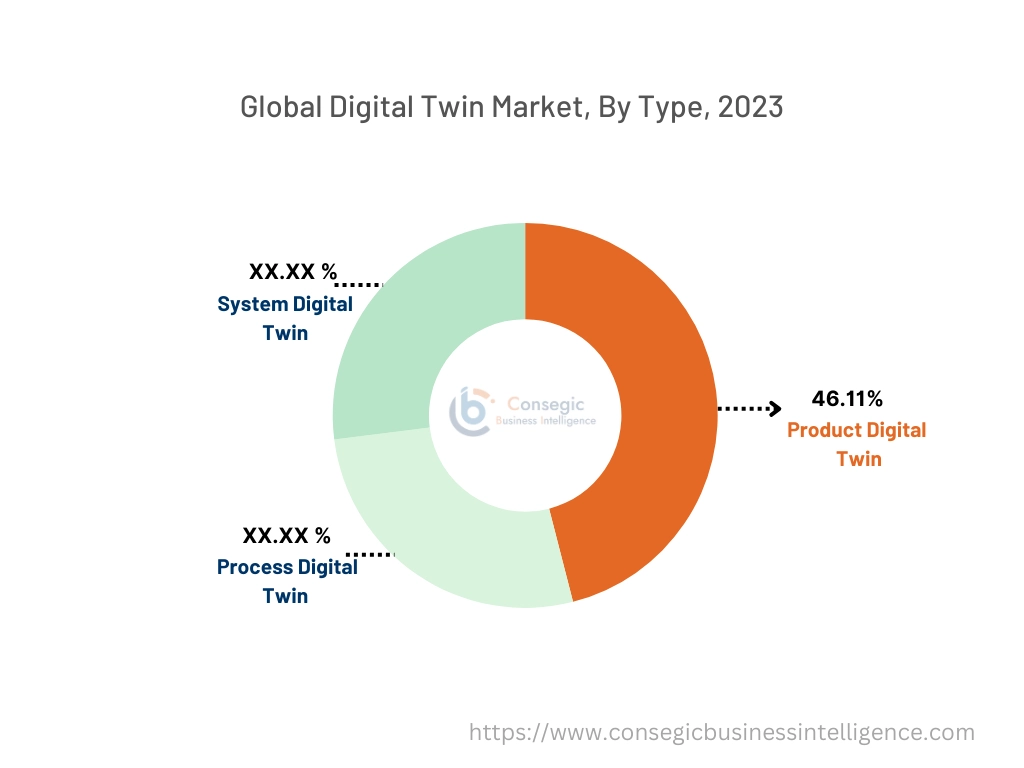
By Application:
Based on application, the market is segmented into predictive maintenance, performance monitoring, asset & inventory management, business & operations optimization, and product design & development.
Trends in the Application:
- These virtual replicas are used for performance monitoring to ensure real-time monitoring of power plants and grids, thereby increasing the overall efficiency.
- They are used in asset & inventory management to reduce store costs and optimization of stocks, by real-time tracking of the inventory status.
The predictive maintenance sector accounted for the largest revenue of the total digital twin market share in 2023.
- Digital twins are utilized for predictive maintenance, mostly to monitor equipment failures and performance, thereby reducing the cost of maintenance and unplanned downtime.
- They are essential in industries such as aerospace, automotive, and heavy machinery to ensure operational efficiency, as the assets are of high value.
- Predicting the failure of the equipment, eventually increases the product lifecycle.
- The integration of AI and machine learning further enhances the prediction accuracy.
- In November 2023, NVIDIA collaborates with Siemens to develop a predictive maintenance-based digital twin, reducing the downtime for power plants.
- Therefore, the reduction in overall cost and the failures, places it as the largest sector by application in the market.
The product design & development sector is anticipated to register the fastest CAGR during the forecast period.
- The usage of digital twins in the product design & development sector, allows the product prototypes to be tested before manufacturing them.
- This allows engineers to redesign the product, reducing the number of design errors and eventually cutting down on the manufacturing cost.
- Many companies use this technology to enhance user experience and get user feedback on the products.
- In March 2023, L&T Technology Services Limited and Ansys signed an MOU to establish the LTTS-Ansys Center of Excellence. This is to allow the implementation of digital twin technology for optimizing designs, and manufacturing and demonstrate various use cases.
- Hence, cost efficiency and product optimization place the product design & development sector as the fastest growing, complementing the digital twin market opportunities.
By Industry:
Based on industry, the market is segmented into manufacturing, healthcare, automotive & transportation, aerospace & defense, energy & utilities, retail & consumer goods, and infrastructure & construction.
Trends in the Industry:
- Digital twins are used in the automotive & transportation sector to simulate vehicle performance and hence improve fuel efficiency and safety.
- They are used to simulate traffic flows, resource allocation, and urban management for smart cities.
The manufacturing sector accounted for the largest revenue share of the overall digital twin market share in 2023.
- Digital twins are used to simulate different scenarios surrounding the product, reducing downtime and utilizing real-time monitoring for operational efficiency.
- The seamless communication between machines and virtual products is enabled by the integration of IoT with digital replicas, further automating the processes in the manufacturing sector.
- In 2022, Accenture and Mars collaborate to integrate AI, cloud, and edge technologies with digital twins to optimize production processes and overall performance.
- Thus, the improvement in productivity and efficiency drives the digital twin market trends.
The healthcare sector is anticipated to register the fastest CAGR during the forecast period.
- In healthcare, customization of treatment planning, and simulation of surgical procedures can be done, allowing better patient outcomes.
- They can predict potential complications in patient health, especially risks involving critical surgeries.
- They are also integrated into medical devices and wearable to enable continuous monitoring of patients.
- For instance, the virtual twin technology by Dassault Systemes , allows users to participate in the 3D anatomy of brain and heart project, predicting the surgical outcomes and the way the drugs can affect the human body.
- Thus, the treatment efficiency and accuracy provided by this technology drive the market growth.
By End-User:
Based on end-user, the market is segmented into large enterprises, and small & medium enterprises (SMEs).
Trends in the End-User:
- To ensure seamless communication between international facilities and efficient operations, large enterprises integrate digital twins.
- They are integrated into AI-driven platforms to give SMEs a competitive edge and allow them to perform predictive maintenance.
The large enterprises sector accounted for the largest revenue share in 2023
- To ensure the production efficiency of large-scale operations, these enterprises use digital twins.
- Informed decisions can be made utilizing the insights provided to enhance the resource allocation process.
- A 2022 case study by ABB, highlights the advantages of ABB's Ability™ Expert Optimizer and advanced process integrated to the simulation model which represents Aitik's grinding circuit, enabling the development of an optimal control strategy.
- The AI and IoT integration allow enhanced large-scale monitoring of global operations.
- In conclusion, efficiency and informed decision-making allow large enterprises to be the fastest-growing segment in the market.
The small & medium enterprises (SMEs) sector is anticipated to register the fastest CAGR during the forecast period.
- Enhanced product quality of product, lower production cost, and downtime are achieved using digital twins by the SMEs.
- The infrastructural investments have been significantly reduced due to the introduction of cloud-based virtual twins, further reducing the cost.
- They are also able to participate in Industry 4.0, with enhanced predictive modeling and improved decision-making.
- In 2021, Slingshop Simulations launched a digital twin project for SMEs, making this technology available to organizations of all sizes.
- In conclusion, the shift towards cloud-based technologies thereby reducing the dependence on physical components and reduced cost, is driving the market demand.
Digital Twin Market Regional Analysis:
The regions covered are North America, Europe, Asia Pacific, the Middle East and Africa, and Latin America.
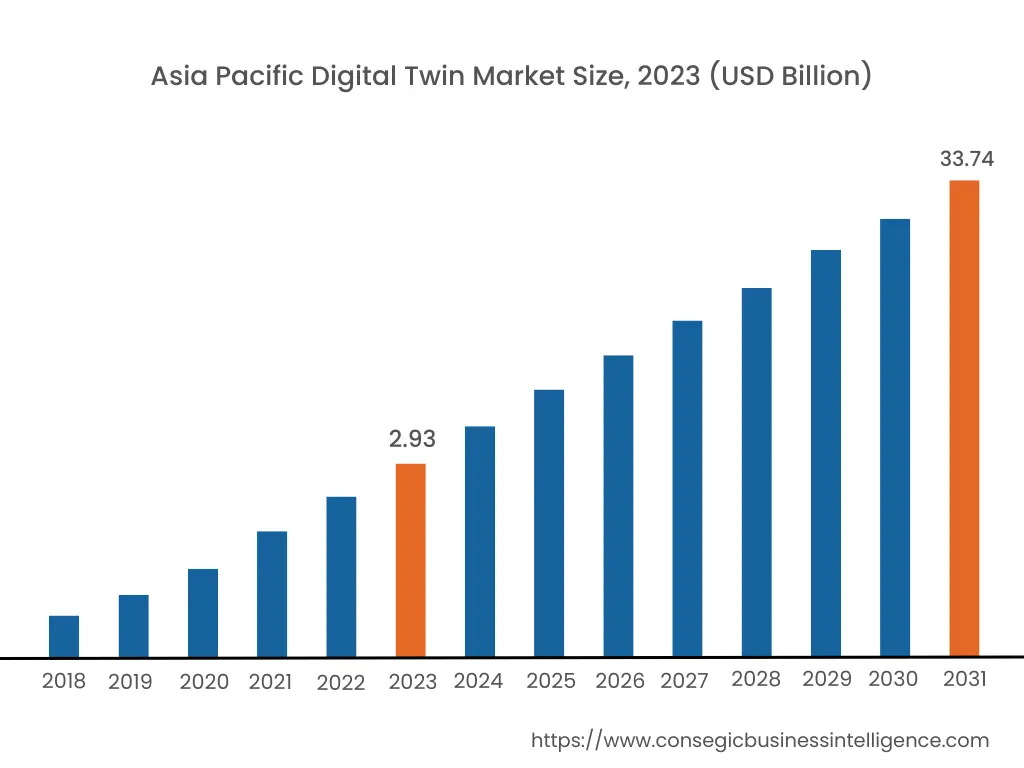
Asia Pacific region was valued at USD 2.93 Billion in 2023. Moreover, it is projected to grow by USD 3.91 in 2024 and reach over USD 33.74 Billion by 2031. Out of this, China accounted for the maximum revenue share of 29.3%.
As per the digital twin market analysis, this growth is due to the rising shift towards industrialization and smart cities. Digital twin technologies are significantly utilized for the management of infrastructure, urban planning, and IoT integration, especially in countries like China, India, and Japan. The government initiatives towards urban development and smart technologies are a few of the contributing factors. These factors contribute to the digital twin market expansion in the region.
- In March 2023, in Jiujiang, Jiangxi province, ZTE and China Mobile launched its first wireless network digital twin application for Extended Reality service. In areas such as parks and squares, the twinning precision reached over 90% according to the test results.
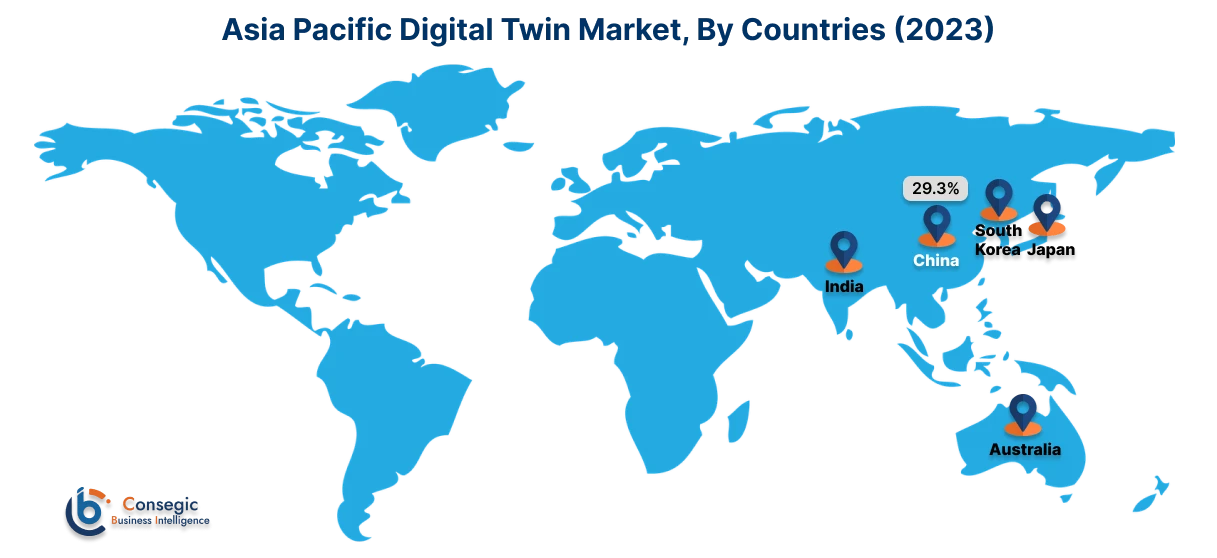
North America is estimated to reach over USD 54.32 Billion by 2031 from a value of USD 4.97 Billion in 2023 and is projected to grow by USD 6.60 Billion in 2024.
This growth is driven by the integration of advanced technologies such as AI and IoT with digital replicas, in various industries in the region, including manufacturing, healthcare, and energy. Other contributing factors include the growing focus on operational efficiency and the prevalence of technology giants like Microsoft Corporation and General Electric (GE).
- In September 2022, the first store digital twin was launched by Lowe's, an American company. It demonstrates a future that allows store associates to interact with all of the store's data, leveraging the NVIDIA Omniverse Enterprise.
The digital twin market analysis shows that the driving factor for Europe's market is the growth in the shift towards Industry 4.0 in the region. The rising demand for smart and sustainable technology in the European Union further accelerates the market growth.
In the Middle East and Africa, the increasing focus on predictive maintenance and asset management is a key driving factor. The move towards operational efficiency in industries like agriculture and manufacturing fuels the digital twin market expansion in the Latin America region.
Top Key Players & Market Share Insights:
The digital twin market is highly competitive with major players providing products and services to the national and international markets. Key players are adopting several strategies in research and development (R&D), product innovation, and end-user launches to hold a strong position in the global digital twin market. Key players in the digital twin industry include -
- General Electric Company (USA)
- Siemens Aktiengesellschaft (Germany)
- Microsoft Corporation (USA)
- ANSYS, Inc. (USA)
- Dassault Systèmes SE(France)
- Robert Bosch GmbH (Germany)
- International Business Machines Corporation (USA)
- PTC Inc. (USA)
- SAP SE (Germany)
- Varo Bank, N.A. (U.K.)
- Oracle Corporation (USA)
Recent Industry Developments :
Product Launches:
- In September 2024, a set of next-generation technologies enabling AI automation and digital twins in semiconductors was launched by Delta and Universal Instruments Corp., which includes the DIATwin Virtual Machine Development Platform. A 20% increase can be seen in new product development with these technologies.
- In May 2024, a new AI-based digital twin technology was launched by Sprinklr, enabling enhanced customer experience by creating a virtual replica of the brand's customer-facing team.
- In October 2023, the Nemetschek Group launched its SaaS Digital Twin platform called "dTwin". It delivers data-driven insights and ensures efficiency considering it is a horizontal and open platform.
Mergers & Acquisitions:
- In February 2024, Unity's Digital Twin Professional Services arm was acquired by Capgemini, aiming to implement digital twins at the industrial level, utilizing the real-time 3D (RT3D) visualization software.
Partnerships & Collaborations:
- In July 2024, Altair & ARAI enter into a strategic partnership, aiming to drive a digital transformation. The integration of Altair's advanced data analytics and simulations coupled with ARAI's consulting services will further accelerate the digital twin technology utilization goal.
- In March 2024, Fujitsu Limited and Carnegie Mellon University entered into a collaboration aiming to conduct, that visualizes traffic situations, including people and vehicles.
Digital Twin Market Report Insights :
| Report Attributes | Report Details |
| Study Timeline | 2018-2031 |
| Market Size in 2031 | USD 142.78 Billion |
| CAGR (2024-2031) | 34.7% |
| By Type |
|
| By Application |
|
| By Industry |
|
| By End-User |
|
| By Region |
|
| Key Players |
|
| North America | U.S. Canada Mexico |
| Europe | U.K. Germany France Spain Italy Russia Benelux Rest of Europe |
| APAC | China South Korea Japan India Australia ASEAN Rest of Asia-Pacific |
| Middle East and Africa | GCC Turkey South Africa Rest of MEA |
| LATAM | Brazil Argentina Chile Rest of LATAM |
| Report Coverage |
|
Key Questions Answered in the Report
How big is the Digital Twin Market? +
Digital Twin Market size is estimated to reach over USD 142.78 Billion by 2031 from a value of USD 13.21 Billion in 2023 and is projected to grow by USD 17.55 Billion in 2024, growing at a CAGR of 34.7% from 2024 to 2031.
What specific segmentation details are covered in the digital twin market report? +
The digital twin market report includes specific segmentation details for type, application, industry, end-user, and region.
Which is the fastest segment anticipated to impact the market growth? +
In the application segment, product design & development is the fastest-growing segment during the forecast period due to its low cost and efficiency.
Who are the major players in the digital twin market? +
The key participants in the digital twin market are General Electric Company (USA), Siemens Aktiengesellschaft (Germany), International Business Machines Corporation (USA), Microsoft Corporation (USA), ANSYS, Inc. (USA), Dassault Systèmes SE (France), PTC Inc. (USA), SAP SE (Germany), Oracle Corporation (USA), Robert Bosch GmbH (Germany).
